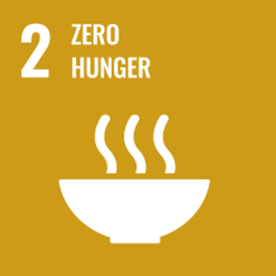Zero Hunger
SUSTAINABLE DEVELOPMENTS GOALS 2 - ZERO HUNGER

Sustainable Development Goal 2 (SDG 2 or Global Goal 2) aims to achieve "zero hunger". It is one of the 17 Sustainable Development Goals established by the United Nations in 2015. The official wording is: "End hunger, achieve food security and improved nutrition and promote sustainable agriculture".[1] [2]SDG 2 highlights the complex inter-linkages between food security, nutrition, rural transformation and sustainable agriculture.[3] According to the United Nations, there are around 690 million people who are hungry, which accounts for slightly less than 10 percent of the world population.[4] One in every nine people goes to bed hungry each night, including 20 million people currently at risk of famine in South Sudan, Somalia, Yemen and Nigeria.[5]
SDG 2 has eight targets and 14 indicators to measure progress.[6] The five "outcome targets" are: ending hunger and improving access to food; ending all forms of malnutrition; agricultural productivity; sustainable food production systems and resilient agricultural practices; and genetic diversity of seeds, cultivated plants and farmed and domesticated animals; investments, research and technology. The three "means of achieving" targets include: addressing trade restrictions and distortions in world agricultural markets and food commodity markets and their derivatives.[6]
Under-nutrition has been on the rise since 2015, after falling for decades.[7] This majorly results from the various stresses in food systems that include; climate shocks, the locust crisis and the COVID-19 pandemic. Those threats indirectly reduce the purchasing power and the capacity to produce and distribute food, which affects the most vulnerable populations and furthermore has reduced their accessibility to food.[8] Up to 142 million people in 2020, have suffered from undernourishment as a result of the COVID-19 pandemic.[9] Stunting and wasting children statistics are likely to worsen with the pandemic.[10] In addition, the COVID-19 pandemic "may add between 83 and 132 million people to the total number of undernourished in the world by the end of 2020 depending on the economic growth scenario".[11]
The world is not on track to achieve Zero Hunger by 2030. "The signs of increasing hunger and food insecurity are a warning that there is considerable work to be done to make sure the world "leaves no one behind" on the road towards a world with zero hunger."[12] It is unlikely there will be an end to malnutrition in Africa by 2030.[13][14]
Source : https://en.wikipedia.org/wiki/Sustainable_Development_Goal_2

